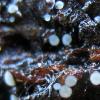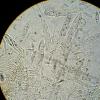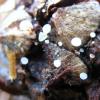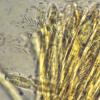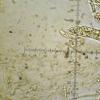
12-11-2025 09:25
 Viktorie Halasu
Viktorie Halasu
Hello, I need help with a pale terrestric Pseudom

11-11-2025 20:16
Bohan JiaHi, lastly I have found these tiny yellow decayin

09-11-2025 13:20
Hello.A tiny ascomycete, appearing as erupting gra

08-11-2025 00:29
 Francois Guay
Francois Guay
I found this species in Quebec, Canada, on herbace
On cones of pinus
Marja Pennanen,
19-10-2009 17:47
I haven't got a clue even of the genus :@
Hans-Otto Baral,
19-10-2009 18:48

Re:On cones of pinus
That's difficult to say. Could be a subsessile Hymenoscyphus. Needs to check the apical ring of the asci with Lugol, and to estimate the type of ring (Hymenoscyphus- or Calycina-type. Did you see any paraphyses and their contents in the living state?
Zotto
Zotto
Marja Pennanen,
19-10-2009 19:02
Re:On cones of pinus
No,
I'm not sure of seeing any paraphyses at all. There seemed to be some, when I looked for them, but, then I figured they were only broken asci.
Sorry I've got no Lugol. But I check them with Meltzer tomorrow at the local university or at least try :) As a novice amateur at scoping I've got no idea of what you are talking about :))
Snowflakes float slowly to the allready white ground here: Marja
I'm not sure of seeing any paraphyses at all. There seemed to be some, when I looked for them, but, then I figured they were only broken asci.
Sorry I've got no Lugol. But I check them with Meltzer tomorrow at the local university or at least try :) As a novice amateur at scoping I've got no idea of what you are talking about :))
Snowflakes float slowly to the allready white ground here: Marja
Hans-Otto Baral,
19-10-2009 19:08

Re:On cones of pinus
The apical rings where the spores are pressed through react in iodine and they have a very different shape between the groups, mainly families, of Helotiales. So if you succeed in a photo of the blue ring in Melzer this would probably help. But with Melzer you could get a negative reaction at all in some species which need KOH-pretreatment. With Lugol you do not need this KOH-pretreatment.
Zotto
Zotto
Marja Pennanen,
19-10-2009 19:14
Marja Pennanen,
19-10-2009 19:20
Marja Pennanen,
20-10-2009 09:42
Re:On cones of pinus
The tiny disco is amyloid (a topic I suprisingly understand).
The spores of the hymenoscyphus or something are about 15-20x3-5 and asci 90-100x7-9.
Snow is melting away revealing all those tiny wonders of nature called ascomycetes: Marja
(Weather is a thing about which people in Finland talk always.)
The spores of the hymenoscyphus or something are about 15-20x3-5 and asci 90-100x7-9.
Snow is melting away revealing all those tiny wonders of nature called ascomycetes: Marja
(Weather is a thing about which people in Finland talk always.)
Hans-Otto Baral,
20-10-2009 10:34

Re:On cones of pinus
Is the last photo made without oilimmersion? It is too small to see the details, and there are too few spores. Is it from the second macro (apos with stalks)? I am sorry, these data are not enough to say something. Usually these species have amyloid ascus tips, but it is important to see the structure of the ring under oil immersion.
Zotto
Zotto
Marja Pennanen,
20-10-2009 10:57
Re:On cones of pinus
I took some photos, but I'm at the university now. Here's no program for my camera. So photo follows in the evening .
The last photo is really without oil. I'll check later weather there is one with immersion.
As a warning: I have found even smaller stipate ascomycetes on cones. So sorry, but this story isn't quite finished yet ;)
Marja
The last photo is really without oil. I'll check later weather there is one with immersion.
As a warning: I have found even smaller stipate ascomycetes on cones. So sorry, but this story isn't quite finished yet ;)
Marja
Marja Pennanen,
20-10-2009 15:01
Marja Pennanen,
20-10-2009 15:04
Hans-Otto Baral,
20-10-2009 20:10

Re:On cones of pinus
For the beforelast photo, the amyloid ring clearly shows that this is no Hymenoscyphus. The spores look a bit scutuloid (apically curved, base I don't see), maybe a Calycellina.
The last photo looks very similar to your second photo, so did you perhaps confuse something? I also wonder about a spore width of 2-4 µm, 2 µm would be good for the Calycellina (unstalked apos) and 4 µm for the stalked apos which might be a Hymenoscyphus. No idea of the species.
Zotto
The last photo looks very similar to your second photo, so did you perhaps confuse something? I also wonder about a spore width of 2-4 µm, 2 µm would be good for the Calycellina (unstalked apos) and 4 µm for the stalked apos which might be a Hymenoscyphus. No idea of the species.
Zotto
Marja Pennanen,
20-10-2009 21:49
Re:On cones of pinus
Thank you Zotto.
When I'm concerned every possible mistake is to be taken into concideration ;) I may have mixed the photos...
But I make the measurements carefully from many spores and then check the limits. Still some extra studies may be needed with these. I may have to send a specimen forward to Turku university.
Marja
When I'm concerned every possible mistake is to be taken into concideration ;) I may have mixed the photos...
But I make the measurements carefully from many spores and then check the limits. Still some extra studies may be needed with these. I may have to send a specimen forward to Turku university.
Marja

